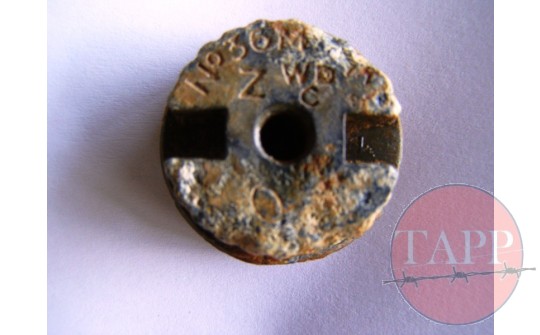Type 36 Mills Grenade End Piece
Item Information:
Catalogue Number: 09/22/001 Source: TAPP Archaeology Surveys Location: No 9 Adam Park Report No: Report No.16 Artifact Type: Ammunition Production Date: 2013-01-16 00:00:00 Dimensions of Item: None Taken Copyright with The Adam Park Project
Other Description:
The base plug would be extracted as part of the fusing process of the grenade. This suggestive that the area was used as a supply dump during the fighting where the process of fusing the weapon was undertaken. This corresponds to the discovery of mortar fuse caps in the same area, again an artefact that would be discarded during the fusing of the mortar rounds.
Historic Context:
The single letter ‘Z’ refers to the type of metal used in the cast, in this case Zinc or the Mazak alloy. In the early 1930s Morris Ashby in Britain had licensed the production of the New Jersey Zamak alloy5. The high-purity refluxer zinc was not available in Britain and so they acquired the right to manufacture the alloy using a locally available electrolytically refined zinc of 99.95% purity. This was given the name Mazak, partly to distinguish it from Zamak and partly from the initials of Morris Ashby. In 1933,National Smelting licensed the refluxer patent with the intent of using it to produce 99.99% zinc in their plant at Avonmouth. The die cast stamp WDC refers to the Wolverhampton Die Cast Company who produced Mazak base plugs for a number of grenade manufacturers including both Josiah Parkes & Sons of Willenhall and John Pilling & Sons of Colne. As the production of components for the government was scattered across a range of manufacturers it was not uncommon for each company to add their own stamp to the item. The No.36M grenade evolved from golf-club designer William Mills’s Grenade No.5, the famous Mills Bomb of World War I. The No. 5 became the Grenade No.23 after obtaining a tail rod that allowed it to be fired from a rifle. In 1918, the grenade was modified to accept a 2.5in (63.5mm) detachable base plate that would let it be launched by a rifle discharger cup. Although this weapon was officially re-designated the Grenade No.36, popularly it was still called a Mills Bomb. A quantity were specially waterproofed and prepared for issue in Mesopotamia were designated No. 36M. While the No.5 and No.23 were removed from service in 1918 and the No.36 was declared obsolete in 1932, the No.36M remained in service as the British Army’s standard grenade.



Comment Here:
Your email will not be published. Required fields are marked *
Related Items:
.303 Riflelite Round
TAPP Archaeology Surveys
Fuse Safety Cap
TAPP Archaeology Surveys
Shell Fragment
TAPP Archaeology Surveys